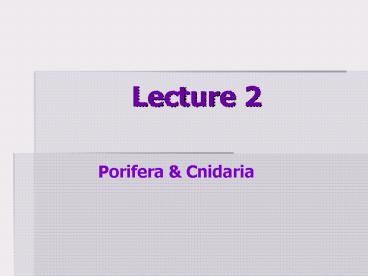Porifera PowerPoint PPT Presentation
Title: Porifera
1
Lecture 2
- Porifera Cnidaria
2
Phylum Porifera The sponges
3
Evolutionary relationships
- Why or Porifera considered animals rather than
Protists? - How do they differ from other animals (3 ways)?
4
(No Transcript)
5
Sponge structure
- Review key parts
- No tissues, organs or body systems!
6
Water movement and feeding choanocyte, Fig. 33.4
- Role of flagellum
- Role of collar
- Movement of particles
- Phagocytosis
7
Amoebocytes
- Move in amoeboid fashion through mesohyle
- Secrete spicules and/or spongin
- finish digestion
- Garbage-collector cells
- Transport waste to excurrent pore
- Can develop into other cell types
- Somewhat like stem cells!
8
Protection
- Sponges are sessile
- Toxins/warning coloration
- Painful or sharp covering (spicules)
- Regenerative ability
- Camouflage (if not toxic)
- Bore into shells.
- NOTE Nudibranch predators co-opt sponge
defenses (toxins, spicules)
9
Nudibranch (Phylum Mollusca, Class Gastropoda)
10
Phylum Cnidaria
Scyphozoa
Anthozoa
Hydrozoa
Cubozoa
11
Phylum Cnidaria
12
Evolutionary relationships
13
Radiata vs. Bilateria
14
Body organization
15
Key features
- Polyps and medusae
- Two germ tissue layers (called..?)
- Mesoglia
- Gastrovascular cavity (functions?)
- Nervous system nerve net
- Neurons? Brain? Nerve cords (bundles of axons)?
- Tentacles with cnidocytes (stinging cells)
16
Cnidocytes/nematocystsHow do they work?
17
Life-history strategies
PowerShow.com is a leading presentation sharing website. It has millions of presentations already uploaded and available with 1,000s more being uploaded by its users every day. Whatever your area of interest, here you’ll be able to find and view presentations you’ll love and possibly download. And, best of all, it is completely free and easy to use.
You might even have a presentation you’d like to share with others. If so, just upload it to PowerShow.com. We’ll convert it to an HTML5 slideshow that includes all the media types you’ve already added: audio, video, music, pictures, animations and transition effects. Then you can share it with your target audience as well as PowerShow.com’s millions of monthly visitors. And, again, it’s all free.
About the Developers
PowerShow.com is brought to you by CrystalGraphics, the award-winning developer and market-leading publisher of rich-media enhancement products for presentations. Our product offerings include millions of PowerPoint templates, diagrams, animated 3D characters and more.

